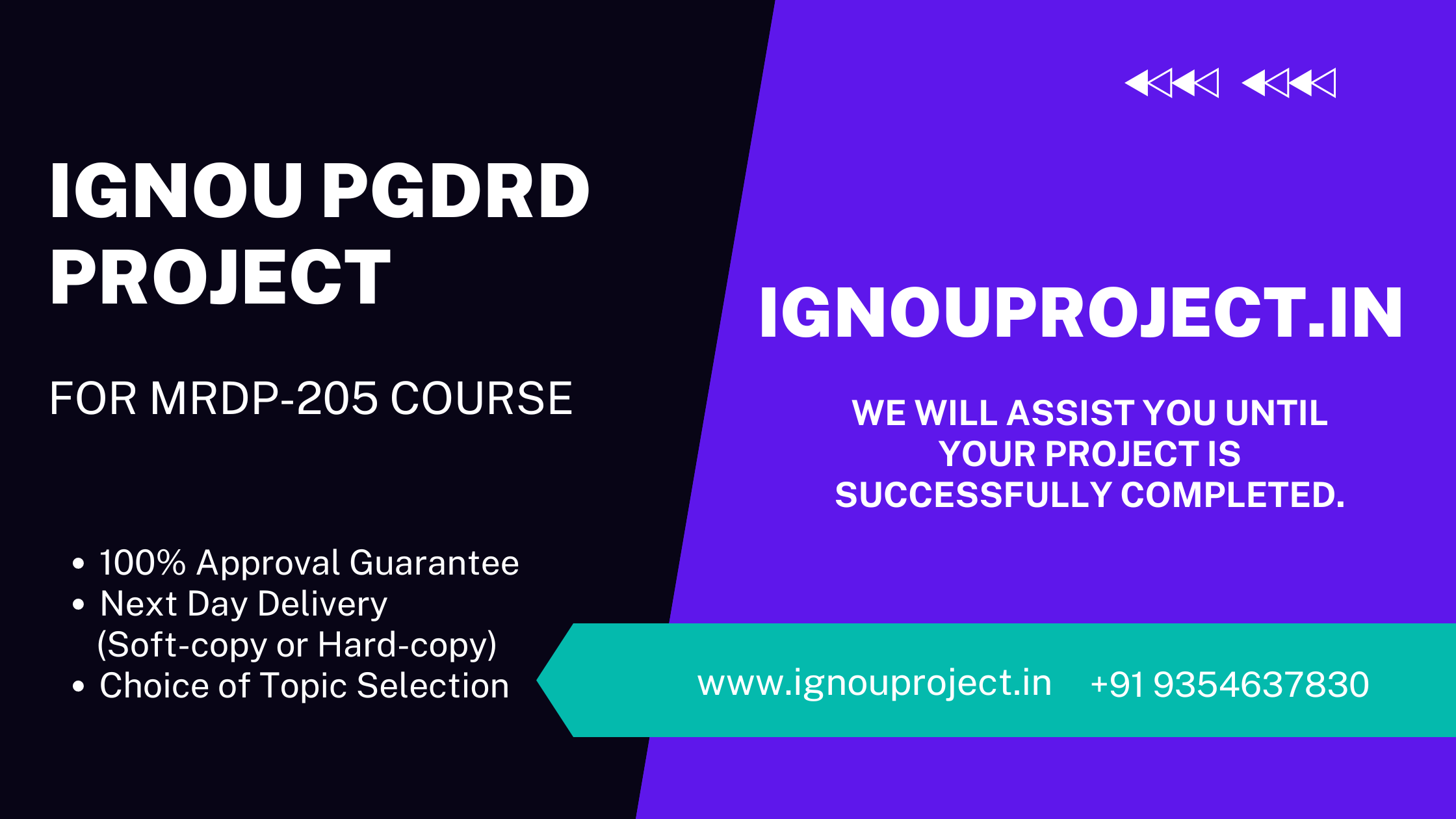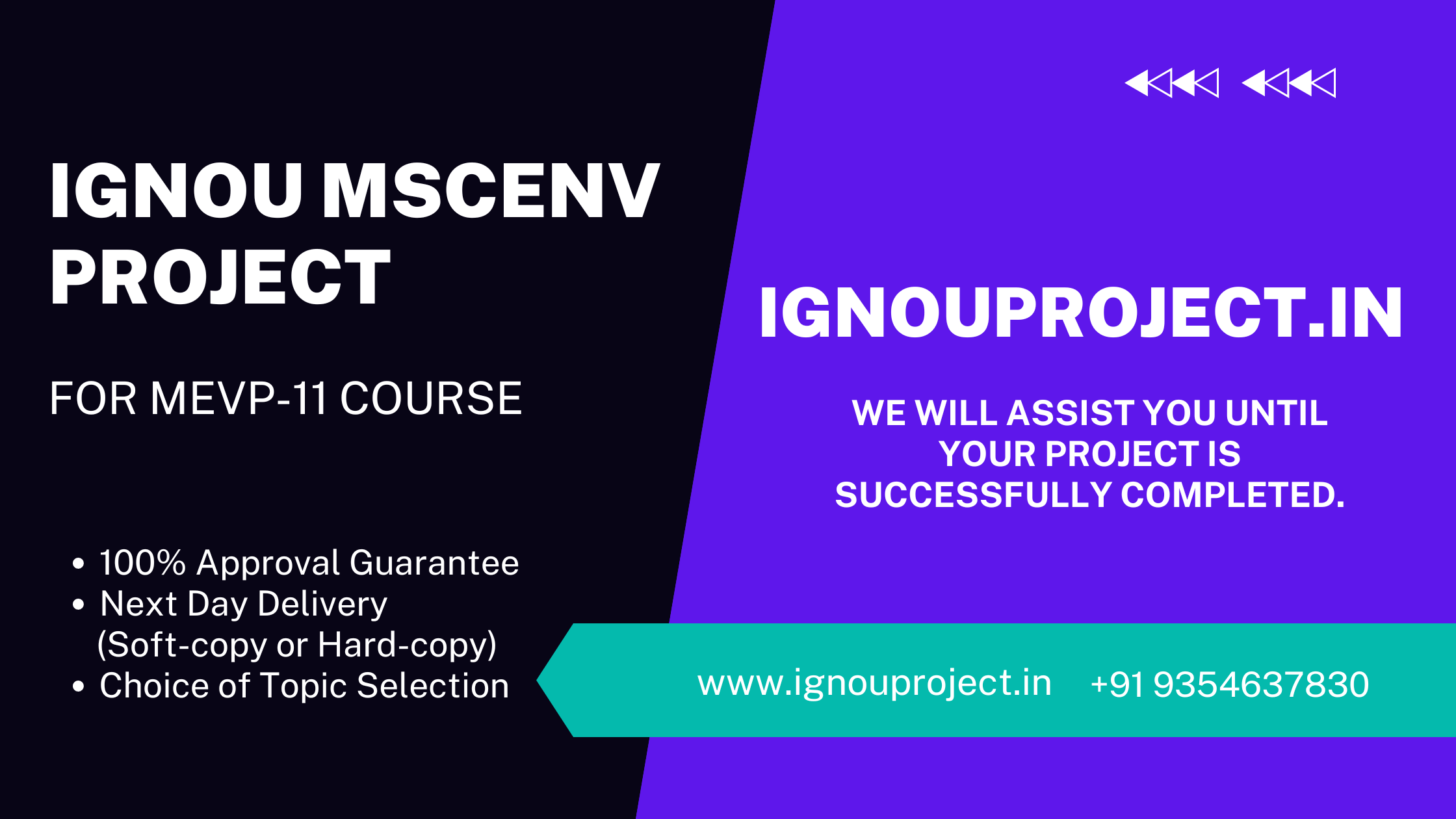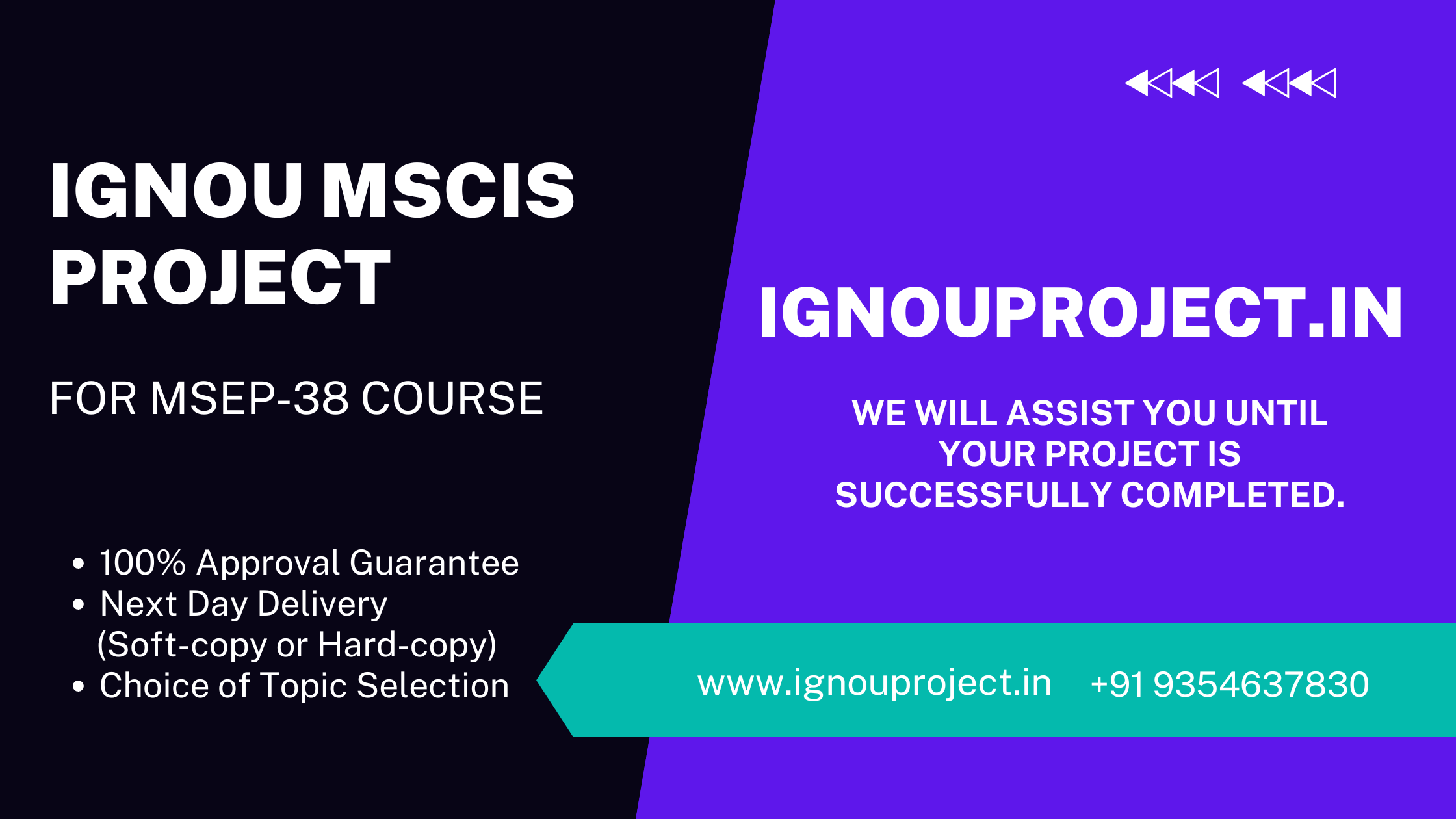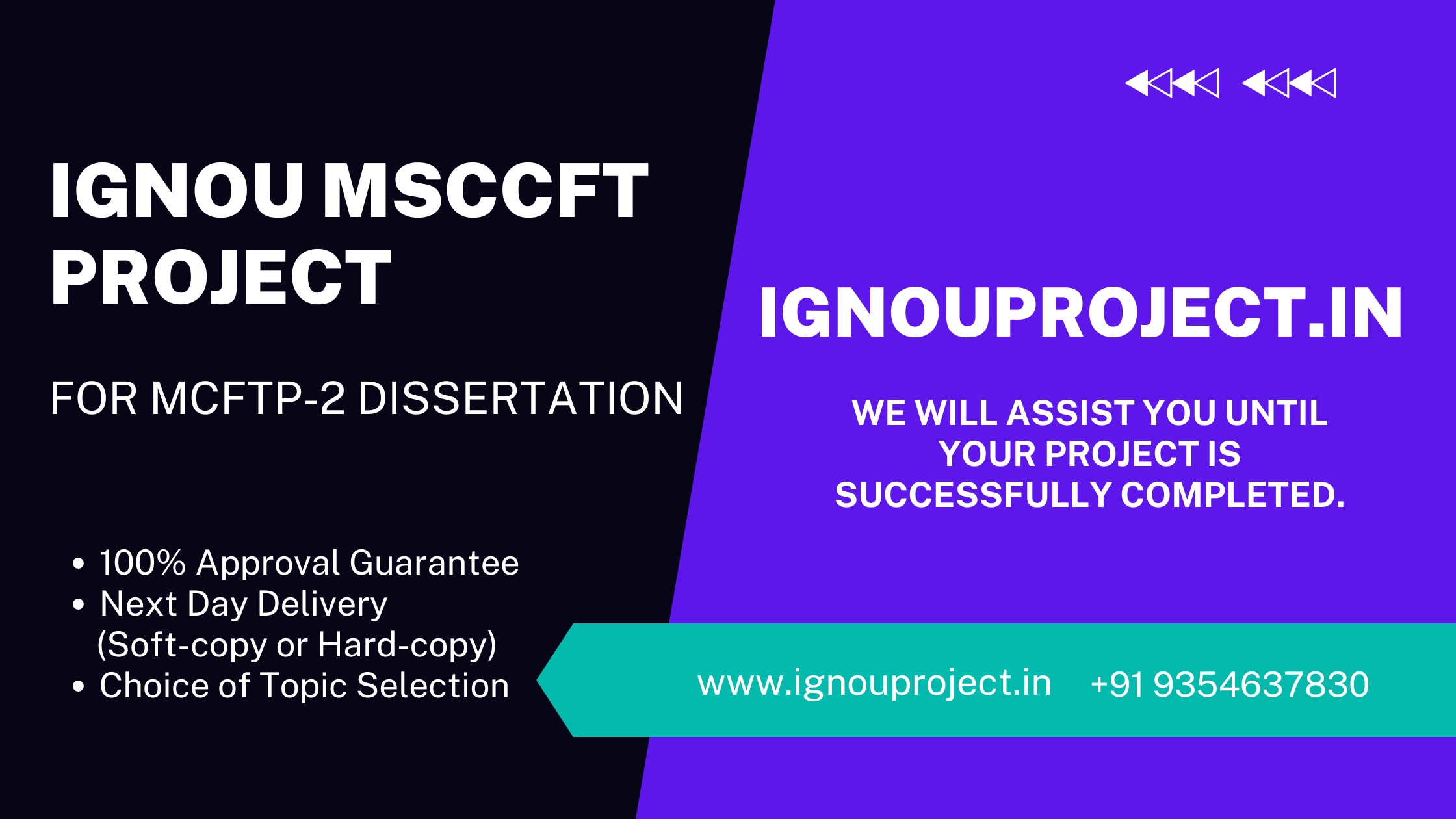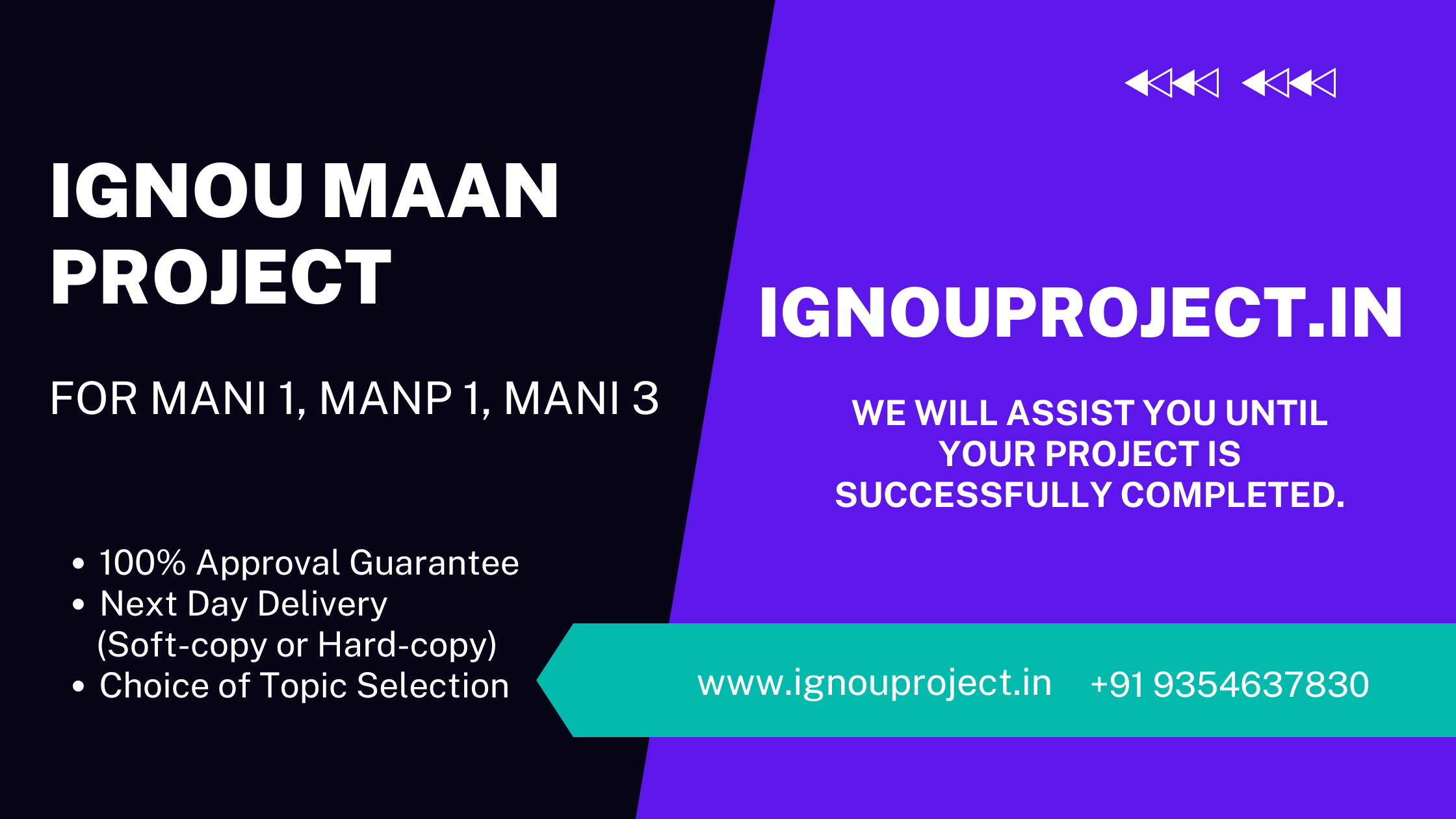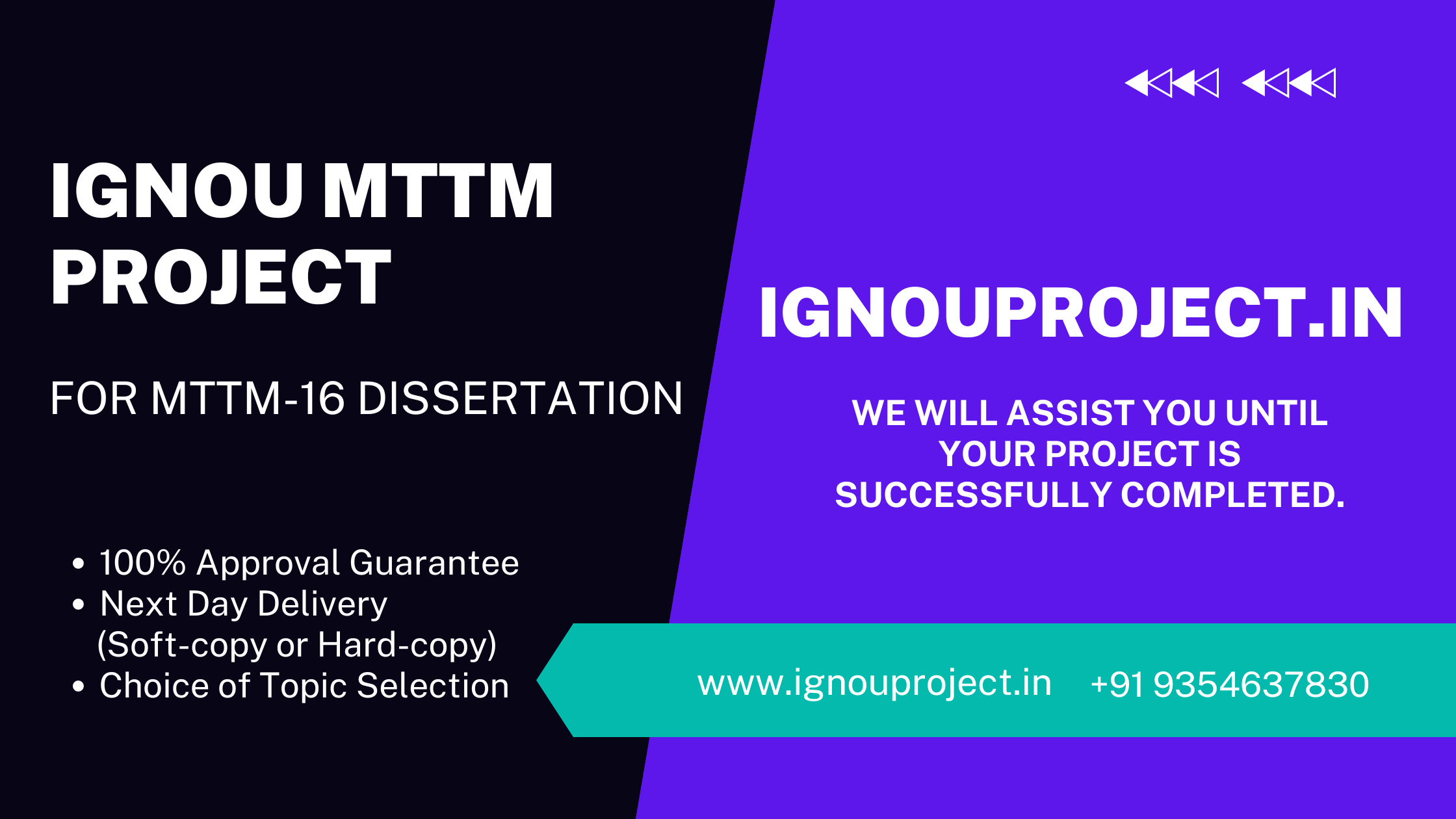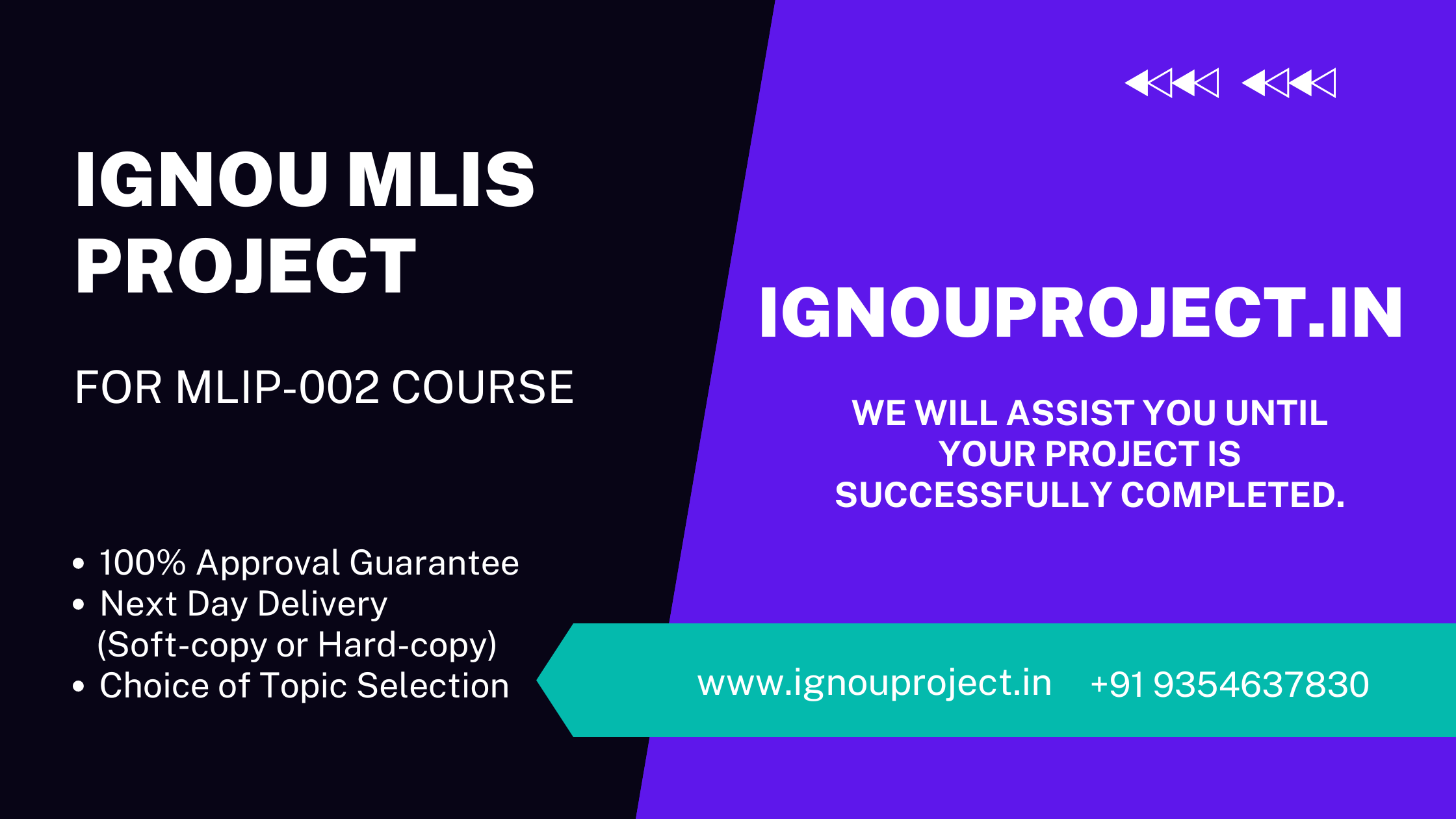Hello, IGNOU PGDRD (Postgraduate Diploma in Rural Development) students! Are you looking for help with your IGNOU PGDRD Project for MRDP 205 course? We’re here to give you with the help and expertise you need to succeed in this critical phase of your program. The MRDP 205 project in Rural Development provides a fantastic chance for you to apply your academic knowledge to real-world difficulties in rural development. Please contact us at 9958947060, 9354637830 if you require specific support or expert advice on your project. Whatsapp us to get the Personalized (Customized) IGNOU PGDRD Project Report and Synopsis Download Link for IGNOU PGDRD Project (MRDP 205 PDF) Importance of IGNOU PGDRD Project for MRDP 205 The Post Graduate Diploma in Rural Development program at IGNOU relies heavily on the MRDP 205 project. This project, which aims to combine thorough rural development studies with practical applications, necessitates careful planning and approval. Students in later phases of their programs are generally entrusted with creating projects that involve substantial research and practical application in topics such as sustainable rural development, agricultural policies, and rural community empowerment. Under the supervision of experienced professionals, students investigate complicated rural development issues, employing approaches and insights learned during their studies. The project concludes with a comprehensive evaluation based on research, outcomes, and a complete report that demonstrates their understanding and practical skills in rural development. This project is not only academically significant, but it also prepares students for professional positions in rural development and associated disciplines. IGNOU PGDRD project topics examples for MRDP 205 You can choose innovative and relevant topics for your IGNOU PGDRD project, such as: Guideline for preparing an IGNOU PGDRD project proposal/synopsis (MRDP 205) The following are some broad but crucial steps that you should consider when preparing your IGNOU PGDRD project proposal. The proposal should not exceed 1,000 words in length. 1. Title of the project The project title should be clear, concise, and descriptive. It will be advantageous if the chosen topic is relevant to your field of work. 2. Formulating the Problem The problem statement should give a brief overview of the problem’s nature and relevance. Existing research is examined to find gaps in knowledge or information. The problem statement provides rationale for conducting the investigation. 3. Goals The objectives should clearly indicate what you aim to study during the course of the project. A research subject often consists of three to four related objectives. You may give them in whatever order you like. Avoid falling to the temptation of setting too many goals. For example, suppose you decide to investigate the subject of child labour. You may opt to investigate the problem’s prevalence, the socioeconomic characteristics of working children, and the causes of child labor. Through the objectives, you will be able to determine the study’s overall scope. 4. Study design A study can be a survey, a case study, an exploratory study, a diagnostic study, or one that focuses solely on hypothesis testing. You should choose the type of study you will do. 5. Hypothesis Testing Hypotheses are not tested in every inquiry. As a beginner, you may want to avoid doing this type of study. If you are certain and your Supervisor feels you are capable of doing so, the hypotheses must be thoroughly defined and the study design constructed accordingly, all under the supervision of your Supervisor. 6. Study’s Context If your project requires fieldwork, you should establish the study’s scope. This will depend on the geographical scope of the investigation and the study unit. For example, if you’re looking at the characteristics of districts in a state, the universe will include all districts. If, on the other hand, you want to look at the features of households in a village, the study universe will comprise all households. 7. Number of samples All units of study are contained inside the universe. Due to the time and effort required to cover every unit of the cosmos, you must select a sample using a scientific method. The sample size should be adequate to ensure that the project is completed on time. 8. Data Collection Instruments You should define the data collection tools that you want to use, such as an interview schedule, an interview guide, and observation. 9. Analyze data It is preferable that the proposal include information on the data analysis and interpretation methods you intend to use. 10. Bibliography (APA format) Bibliographies must be APA formatted. These can be arranged alphabetically. Guideline for preparing the IGNOU PGDRD Project Report (MRDP 205) After completing the research work in accordance with the requirements of the IGNOU PGDRD proposal, you must write a detailed account of the research work, emphasizing the statement of the problem, the research objectives, the study’s hypothesis(es) based on a review of the related literature, the method and procedures used in sample group selection, tool development and use, and data collection. An IGNOU PGDRD Project Pdf goes over each of these points in detail. Writing a dissertation necessitates respect to specific regulations and concepts. General Format for IGNOU PGDRD Project Pdf There are numerous style manuals available for presenting a dissertation report; these manuals guide us through the specific rules, style, and structure to follow when conveying the research project’s objectives, methodology, processes, and findings. Why Getting Professional Help for your IGNOU PGDRD Project (MRDP 205)? Get our expert help to start your MRDP 205 project journey Our PGDRD Project Fees for MRDP 205: Our offerings for the PGDRD Project include: Our Promises: Get your IGNOU PGDRD Project Report & Synopsis Sample PDF Begin your PGDRD Project with assurance, understanding that you will receive extensive assistance at every stage of the process. Under our supervision, your project has the potential to become a noteworthy academic accomplishment and a meaningful addition to the subject of Rural Development. Reach out to us immediately and allow us to transform your project concept into a remarkable academic achievement!
IGNOU MSCENV Project for MEVP 11
Initiating your IGNOU MSCENV Project is a crucial milestone in your journey towards obtaining your MSc in Environmental Science degree from IGNOU. This project serves not only as a prerequisite for academic fulfillment but also as a manifestation of your proficiency in the field of environmental science. Our tailored advice aims to enhance your project, exceeding academic standards and representing a notable accomplishment in your academic path. To receive assistance in developing your environmental science research, please contact us at 9958947060, 9354637830. Whatsapp us to get the Personalized (Customized) IGNOU MSCENV Project Report and Synopsis Download Link for IGNOU MSCENV Project (MEVP 11 PDF) Importance of IGNOU MSCENV Project for MEVP 11 The MEVP 11 project is an essential component of the MSc in Environmental Science program at IGNOU. This project requires careful consideration and approval as it combines in-depth environmental studies with sustainable development strategies. Advanced stage students are assigned projects that require extensive research and practical application in areas such as sustainable resource management, environmental policy analysis, ecosystem conservation strategies, and sustainable development practices. Under the guidance of seasoned professionals, students tackle complex environmental issues, utilizing the approaches and insights they have gained through their studies. The project concludes with a thorough assessment that relies on research, results, and an elaborate report, demonstrating their understanding and practical abilities in the fields of environmental science and sustainable development. In addition to its academic importance, this initiative prepares students for professional positions in these interrelated fields. IGNOU MSCENV Project Topics (MEVP 11) You can choose innovative and relevant topics for your IGNOU MSCENV project, such as: Instructions for preparing a project proposal/synopsis for the IGNOU MSCENV Project (MEVP-11) When preparing the IGNOU MEVP-11 Synopsis/Proposal, it is important to consider the following points: 1. When selecting a topic for an IGNOU MSCENV synopsis, consider the following factors: The Project Proposal must specifically incorporate the Title, Introduction, Objectives, Problem Statement, Research Methodology (containing the location, sample size, instruments, and statistical techniques to be employed), Limitations if applicable, and References. 2. Seek guidance from your supervisor to help you narrow down the topic. The individuals listed below possess the necessary qualifications to serve as supervisors for the IGNOU MSCENV Project: In the event that the School of Interdisciplinary and Transdisciplinary Studies finds the suggested supervisor unsatisfactory, the student will be notified and advised to submit a revised request with a different supervisor. Consequently, the student is required to submit the IGNOU MSCENV Proposal again, but this time with the signature of the new supervisor. This will be regarded as a whole new submission. Likewise, if a student chooses to switch supervisors for any reason, they must present the project proposal together with the new supervisor’s signature on a fresh project proposal proforma, as this would be considered a new submission. Academic counselors must clearly specify the specific courses they are providing guidance on and the duration of their advisory role. Additionally, they should provide the name and code of the study center to which they have been assigned. The University will provide a compensation of Rs.300/- to the project supervisor for their role in counseling the student. Please note that this payment may be subject to revision in the future. Duties and obligations of a supervisor 3. Submission and Approval of an IGNOU MSCENV Project Proposal Once students have selected a supervisor and determined a topic, they must submit the Project Proposal Proforma, together with a signed copy of the Project Proposal endorsed by the supervisor, and the supervisor’s bio-data to the Coordinator (MSCENV), IGNOU, located at Maidan Garhi, New Delhi-110068, for approval. Students accepted for the January session must submit project proposals by April 30th, while those accepted for the July session should submit projects by October 31st to ensure prompt approval and completion of the program. Students who are unable to meet these deadlines have the option to submit an IGNOU MSCENV Synopsis/Proposal for approval at any point during the academic year. 4. Approval Communication The student will get a formal notification on the approval or rejection of the project within six weeks of the School receiving the proposal. This notification will be sent by email and regular mail. 5. Resubmission Request for IGNOU MEVP-11 Synopsis/Proposal In the event that the idea is not accepted, the student will receive feedback and recommendations on how to enhance the IGNOU MEVP-11 Project Proposal. For this situation, please submit the amended project proposal along with the modified project proposal proforma, a copy of the rejected project proposal, and the project proposal proforma including the evaluator’s thoughts and the allocated P.P. No. Instructions for writing the IGNOU MSCENV Project Report (MEVP-11) When preparing the IGNOU MSCENV Dissertation/Project, it is important to examine the following points: 1. Formation of abstract ideas or concepts. The report should have a length of approximately 40 to 50 double-spaced written pages, with a maximum word count of around 10,000 words (excluding appendices and exhibits). Nevertheless, a tolerance of 10% is allowed in both directions. The project report should consist of the following sections: Title, Introduction, Objectives, Problem Statement, Research Methodology (containing details about the location, sample, instruments, and statistical techniques to be used), Results and Discussion, Summary, and any limitations. Furthermore, the IGNOU MSCENV Project Report must encompass the following: 2. Submission of an IGNOU MSCENV Project Report One printed version of the IGNOU MSCENV Report should be mailed to the Registrar of IGNOU’s Students Evaluation Division at Maidan Garhi, New Delhi-110068. Upon submission of the IGNOU MSCENV Dissertation, the student will receive a P.R. No. assigned to them. When contacting the Students Evaluation Division on the Project Report, the student should include the reference number P.R.No. An IGNOU MSCENV Dissertation Project can be submitted at any time during the year. If a Project Report is submitted during the period from December 1st to May 31st, the result will be announced simultaneously with the June term-end examinations. The announcement of the project report’s outcome will coincide with the December
IGNOU MSCIS Project for MSEP-38
The IGNOU MSCIS Project for MSEP-38 course code is a crucial part of the Master of Science (Information Security) (MSCIS) degree, demonstrates your competence and expertise in computer science and information systems. We design our expert guidance to ensure that your project not only meets but surpasses academic standards, marking a key achievement in your educational path. Connect with us at 9958947060, 9354637830 for assistance in developing your project in computer science and information systems. Whatsapp us to get the Personalized (Customized) IGNOU MSCIS Project Report and Synopsis Download Link for IGNOU MSCIS Project (MSEP-38 PDF) The MSCIS program at IGNOU includes the MSEP 38 project as a fundamental element. Its aim is to blend advanced computer science theories with practical applications in information systems. Students in the advanced stages of their studies should formulate and obtain approval for their project proposals. These projects demand thorough research and practical application in areas such as algorithm development, data management, system analysis, and software engineering. Seasoned professionals guide students as they tackle complex problems in computer science, applying methodologies and insights gained throughout their coursework. They conclude the project with a detailed assessment based on their research, findings, and a comprehensive report, demonstrating their depth of knowledge and practical skills in computer science and information systems. Not only academic completion but also preparing students for professional roles in these interrelated fields is essential for this project. IGNOU MSCIS Project Topics (MSEP-38) You can choose innovative and relevant topics for your IGNOU MSCIS project, such as: What are the specific instructions for writing an IGNOU MSCIS Project? IGNOU offers a project guide that clearly defines the requirements and structure for the MSCIS project reports (MSEP-38/038). Below is a concise overview of the essential documentation guidelines: Form: Sections: Guidelines for composing your IGNOU MSCIS Project for MSEP-38 Discover the necessary procedures to complete your MSEP-038 project. Request for consideration Prior to commencing, document the subject matter of your MSEP-38 project. A proposal refers to this document. Your teachers must review it and provide you permission. Engage in conversation with the supervisor Your supervisor possesses a vast amount of knowledge. Engage in a conversation with them regarding your MSCIS project. They can provide guidance and offer insights that you may not have previously contemplated. Engage in the act of reading and acquire knowledge Delve deeply into your subject of Master of Science in Information Security. Engage in the consumption of articles, movies, and the act of taking notes. However, it is imperative to avoid plagiarizing from others. It is expected that the work you produce should be entirely your own. Gather information Various initiatives require distinct types of data. Certain individuals may require interviews, whereas others may necessitate tests or experiments. Ensure that you obtain precise and truthful information. Time for Writing Commence the act of writing at this moment. Consolidate all your ideas for your Master of Science in Computer and Information Science course. Ensure that your writing is unambiguous. Exercise patience and avoid hurrying. Allocate an appropriate amount of time to ensure that the task is completed accurately and effectively. Provide proper attribution for your references When utilizing information from many sources such as books, internet, or any other medium, it is important to acknowledge and cite the source. This practice is referred to as citation, and it holds significant importance. Online tools can be utilized to assist with the composition of an Ignou MSCIS project You have companions in your MSCIS course. The internet offers an abundance of materials to assist you. There are complimentary templates available, as well as online discussion boards for engaging with fellow students. However, it is important to keep in mind that these are merely instruments designed to assist you. Devote your primary attention to your Ignou MSCIS project work. Some Efficient Strategies Significance of Professional Assistance for your IGNOU MSCIS Project (MSEP 38) Embark on your MSEP-38 project journey Our Service fee for the MSCIS Project include: Our Dedication to You Get your IGNOU MSCIS Project Report & Synopsis Sample PDF Begin your MSCIS Project with assurance, understanding that you will receive extensive assistance at every stage of the process. Under our supervision, your project has the potential to become a noteworthy academic accomplishment and a meaningful addition to the subject of Information Security. Reach out to us immediately and allow us to transform your project concept into a remarkable academic achievement!
IGNOU MSCCFT Project Dissertation for MCFTP-2
Greetings, students of IGNOU MSCCFT (Master of Science in Counselling and Family Therapy)! Are you ready to start your IGNOU MSCCFT project? We are here to provide you with the assistance and specialized knowledge necessary for you to flourish in this crucial aspect of your program. The IGNOU MCFTP-2 project in Counselling and Family Therapy offers a distinct chance to apply your theoretical knowledge to real-life situations. If you require support to guarantee the exceptional quality of your project, please don’t hesitate to contact us at 9958947060, 9354637830. Whatsapp us to get the Personalized (Customized) IGNOU MSCCFT Project Dissertation and Synopsis Download Link for IGNOU MSCCFT Project Dissertation (MCFTP-2 PDF) The Significance of the IGNOU MSCCFT project dissertation in your MCFTP-2 Course The MCFTP-2 project is not merely a prerequisite, but rather a crucial component of your educational progression in the field of Counselling and Family Therapy. The reason why it is really important is as follows: IGNOU MSCCFT Project Dissertation Topics (MCFTP-2) You can choose innovative and relevant topics for your IGNOU MSCCFT project, such as: Instructions for composing the IGNOU MSCCFT Project Dissertation A dissertation structure has essential elements such as a title, an introduction, headings, a conclusion, and a bibliography. Do you require approval for your IGNOU MSCCFT Dissertation topic? Indeed, it is imperative to obtain approval for your dissertation topic prior to commencing your research project. This can facilitate timely modifications and establish a solid groundwork for a scholarly research investigation. Prior to proceeding, it is imperative that you obtain authorization from your lecturer, committee members, and the thesis reviewer assigned by your department. You may want to explore an alternative issue that does not require approval if you cannot obtain approval or anticipate it to be time-consuming. If you intend to publish excerpts from your dissertation in academic journals or books, it is advisable to obtain permission beforehand. Authors are often obligated by academic publishers to obtain permission for any copyrighted materials from third parties that are featured in their publications. Where can you find materials to assist you in writing your IGNOU MSCCFT project dissertation? Below are many sites that will assist you in writing your IGNOU MSCCFT Project Dissertation: Furthermore, your adviser, other faculty members, and librarians are also available to provide assistance. They can offer you assistance in your research, writing, and formatting endeavors. Guidelines for composing an MCFTP 2 dissertation: Where do you submit the finalized IGNOU MSCCFT Project Dissertation? IGNOU has implemented an online platform for the submission of final projects, dissertations, field work journals, and internship reports. Students have the option to submit their dissertations to the relevant school at www.ignou.ac.in, namely under the section titled “about IGNOU” and then “School of Studies”. The email addresses of all faculty members may be found at http://www.ignou.ac.in/ignou/aboutignou/school. Students may also reach out to their respective Regional Centre for any inquiries regarding their submitted projects, dissertations, field work journals, or internship reports. The email addresses of the corresponding Regional Centres can be located on their individual IGNOU Regional Centre websites. To inquire about the acceptance of project proposals, students can contact The Coordinator (Projects) at the School of Management Studies, IGNOU, located at Maidan Garhi, New Delhi-110068. Students seeking information on project reports should contact the Registrar (SED) at IGNOU, located in Maidan Garhi, New Delhi-110068. What are the specific requirements for the dissertation in the Master of Science in Counselling and Family Therapy degree at IGNOU? The Master of Science (Counselling and Family Therapy) (MSCCFT) program at IGNOU requires students to submit a dissertation. This dissertation should be a paper written in English, consisting of 100 to 150 pages and typed. The report must contain certificates, appendices, and enclosures. The paper must be centered around a research topic that pertains to counseling and family therapy. Online resources can be utilized to access literature reviews, secondary data, and sources for your dissertation. Reasons why choose our services for your IGNOU MSCCFT Project Our Dedication to You Embark on your MCFTP-2 project journey Our Fees for Outstanding Services: Our offerings for the MSCCFT Project include:
IGNOU MARD Project Dissertation for MRDP-1
Greetings, students of IGNOU MARD (Master of Arts in Rural Development)! Are you preparing for your IGNOU MARD Project? We are here to offer you the essential assistance and specialized knowledge to succeed in this vital aspect of your program. The MRDP-1 project in Rural Development offers a valuable chance for you to utilize your academic expertise in addressing practical rural development challenges. If you require individualized support and professional guidance for your project, please do not hesitate to contact us at 9958947060, 9354637830. Whatsapp us to get the Personalized (Customized) IGNOU MARD Project Dissertation and Synopsis Download Link for IGNOU MARD Project Dissertation (MRDP-1 PDF) Significance of the IGNOU MARD Project (MRDP-1) in your MA Rural Development (MARD) Course The MRDP-1 project is not solely an academic assignment, but rather a crucial element of your Master’s degree. The following explanation highlights the significance of this matter: IGNOU MARD Project Dissertation Topics (MRDP-1) You can choose innovative and relevant topics for your IGNOU MARD project, such as: Structure of IGNOU MARD Project Proposal (MRDP 1) Utilize the IGNOU MARD Project Proposal to construct the IGNOU MRDP 1 proposal in the specified format: Structure of IGNOU MARD Dissertation Sample (MRDP 1) After finishing the research as outlined in the research proposal, you need to write a comprehensive report that highlights the problem statement, research objectives, hypotheses based on a review of relevant literature, the methods and procedures used for selecting the sample group, developing and using tools, and collecting data. An exhaustive analysis of all these domains is encompassed in an IGNOU MARD Dissertation/Project Report. Producing a dissertation necessitates strict compliance with specific regulations and principles. There are many style manuals that can be used to deliver a dissertation report. These manuals provide guidance on the precise rules, style, and structure to follow when communicating the objectives, methodology, processes, and conclusions of a research project. Nevertheless, all forms bear a resemblance to the subsequent structure, which comprises three primary divisions; Section I: Introduction 1) The Title Page: The main content of a research report is preceded by different sections of introductory material. It encompasses the subsequent facts in a comprehensive manner. i) The dissertation’s title ii) The organization to whom the dissertation will be presented. iii) The student’s name (optionally, the previous academic degree might be given following the name). iv) The month and year of dissertation submission 2) Introduction: Often, the prelude provides a concise elucidation of the dissertation report’s objective and extent. Moreover, it is important to express appreciation to individuals who offered significant guidance or assistance throughout the implementation of the dissertation. If you have minimal comments regarding the contribution of their study project, you can simply exclude the prologue. In this particular situation, it is more appropriate to designate the page as “Acknowledgements” instead of “Preface”. Acknowledgements should be concise and straightforward. An extended sequence of excessively apologetic statements filled with excessive praise is not deemed acceptable. The concise acknowledgements section should convey appreciation to the persons and organizations that have provided academic, administrative, and facility support. 3) Contents: The contents consist of an introduction, chapters with sub-sections, a bibliography, appendices, and page numbers. Furthermore, the table of contents consists of a prologue or acknowledgements, a table of contents, and a table of figures. Section II: The main content of the report The report is structured into four coherent sections, each including essential information. 1) Introduction: The introduction of the dissertation report should be concise, comprehensive, and concise. The research problem should be presented in a way that provides context and engages the reader’s attention. In the introduction part, you establish, examine, and express the essence of the problem in relation to the objectives of the research. In addition, you analyze similar publications to establish a basis for formulating hypotheses. The introduction also addresses the importance of the issue and the need for doing a dissertation investigation. Upon evaluating the background, scope, and constraints of the problem, you introduce the research inquiries, study goals, hypotheses, and, if applicable, assumptions, along with operational definitions for the terminology included in the study’s title. 2) The study’s design/methodology: This part provides an extensive explanation of the study’s design. The document provides an elaborate account of the research methodology employed in the study, including details about the population’s attributes, sample size, sampling method, data collection tools and techniques, data collection procedure, as well as the chosen quantitative and qualitative data analysis methods and the reasoning behind their selection. 3) Data analysis and interpretation: This aspect of the research report is crucial. The data analysis and interpretation might be presented either in distinct chapters or consolidated into a single chapter. The data are presented in tabular and graphical formats, complemented by written annotations. Elaborate and comprehensive tables should be placed in the appendix to avoid compromising the clarity of the textual analysis. The report should avoid replicating all of the exact material included in the tables and figures of the textual discussion. The primary objective should be to highlight the most crucial data and connections in order to derive meaningful insights and reach conclusions. Any flaws or limits in the study’s design, tools, or population that were recognized during the project’s completion should be acknowledged without hesitation, as well as the manner in which these elements influenced the study’s conclusions. 4) Conclusions and summary: This section provides a concise overview of the topic, the objectives and hypotheses of the study, the methodology employed, and the findings, conclusions, and recommendations for future research. The conclusions are concise and directly align with the study’s objectives and tested hypotheses. The authors clearly describe whether the study’s findings support or contradict the premise(s), as mentioned before. Conclusions offer solutions to the problems addressed and modify existing knowledge. In addition, the researcher may emphasize unresolved difficulties that arose during the study and require further investigation beyond the boundaries of the problem being addressed. The debate and presenting of findings should evoke a feeling of fulfillment and
IGNOU MAAN Project Dissertation for MANI 1, MANP 1 & MANI 3
An Overview of IGNOU MAAN Project Dissertation Anthropologists study human behavior and cultures, making anthropology a significant field of study. Anthropologists conduct their research in collaboration with others, working towards a common goal through IGNOU MANP projects. Participants cooperate to achieve shared objectives in a MANP project, which is a research endeavor. The original participant’s group usually has different aims from those of this anthropology project. This guide will provide you with instructions and recommendations on how to conduct the project work for this course, as well as its benefits. One credit is accounted for by the project work and should not exceed a maximum of 30 hours. You can allocate this time as three hours per day or allocate it as needed for the project. Project work is a crucial requirement for the course as it intends to make anthropology an applied science that can be put into practice. The project work will showcase the methods and approaches that we learned at the beginning and end of the course. Examples or concerns that can be applied may serve as central lessons. The final practical Block, which is based on the seven lessons, will prepare you for various career opportunities in anthropological fields. Practicing and applied Anthropology should base this project on concepts and aspects. Anthropology benefits from project work as it deepens understanding of the subject and fosters its development through new insights. The practice of anthropology, as a sub-discipline in anthropology, applies anthropological knowledge to bring about change in various areas of society, ranging from social to biological. Students will practice conducting research in a way that fosters positive change in these fields through the project work. The process of discovering and acquiring knowledge is done through a systematic approach. Choose a subject or theme from either biological anthropology, social anthropology, or both. You will develop key skills as an anthropologist through the project work, which will allow you to gain a deeper understanding of the subject and its connections through fieldwork. You document your entire research process through Anthropology Project Report Writing. Defining the project you wish to complete and identifying the problem is essential. Solving the problem from an operational perspective requires a well-defined research problem. Another critical step is the research design, and your project should emphasize practicing or applied anthropology. Whatsapp us to get the Personalized (Customized) IGNOU MAAN Project Dissertation and Synopsis Download Link for IGNOU MAAN Project Dissertation (MANI 1, MANP 1 & MANI 3 PDF) IGNOU MAAN Project Topics (MANI 1, MANP 1 & MANI 3) You can choose innovative and relevant topics for your IGNOU MAAN project, such as: 1. Social media impacts cultural identity among young adults in India. 2. Women in rural communities and their roles in the wake of economic reforms. 3. Migrant workers in urban India faces experiences and challenges. 4. Globalization impact on traditional food systems in indigenous communities. 5. Religion role in conflict resolution and peacebuilding. 6. Humans evolved bipedalism in their evolutionary history. 7. Climate change impacts human health and migration patterns. 8. Human populations around the world exhibit genetic diversity. 9. Nutrition role in human growth and development. 10. Skeletal analysis 11. Ancient civilizations 12. Agriculture developed and impacted human societies. 13. Trade and exchange role in the development of complex cultures. 14. Archaeologists evidence to understand ancient religions and belief systems. 15. Nutritional status of pre-school children. 16. Diabetic women’s nutritional status. 17. Climate change in India. 18. Biodiversity of Jim Corbett National Park. 19. A study on the smartphone addiction, general health, and self-esteem of adolescents. 20. Knowledge, attitude, and practice regarding the deficiency of Vitamin D in people of XYZ city. 21. Rural adolescent girls’ menstrual hygiene practices and beliefs. 22. Working women in government offices to examine their work-life balance. 23. A study is being conducted on hypertension among people of XYZ city. 24. A study on the knowledge, attitudes, and practices about earthquake preparedness. 25. Women’s human rights violations. 26. Gender studies 27. Anthropologists study environmental anthropology. 28. Medical anthropology studies 29. Political anthropology studies 30. Anthropologists study development. What components should be incorporated in the IGNOU MAAN Project Proposal? An effectively organized MAAN project proposal, commonly submitted for the initial-year project (MANI-001, MANP-001, MANI-003), should include the subsequent essential sections: Requirements for IGNOU MAAN Project Report (MANI 1, MANP 1 & MANI 3) Supervisor/Guide Eligibility A mentor will provide guidance and support throughout your Project Work. A mentor is a somebody who possesses expertise in the field of applied or practice anthropology and may provide guidance to learners in selecting an appropriate topic. The individual must occupy a prestigious job in a university or institute. Prior to commencing the project, it is necessary to submit a concise curriculum vitae and a summary or proposal of the project to the MAAN Coordinator at IGNOU New Delhi. Structure of Project Report The report should be meticulously presented, adhering to a prescribed structure: It is imperative to recognize the origins of information in your text and furnish comprehensive details in the form of references. References facilitate the reader’s ability to swiftly identify the source of the investigation that forms the basis of your project. In addition, they aid the reader in evaluating your work by appraising the precision of your citations and your comprehension of the subject matter. Accurate referencing of sources is crucial for a thoroughly documented project report. MAAN Project Submission Kindly deliver a single copy of the Project Work to the Registrar of the RSC. The project work/dissertation can be submitted either by insured registered mail/insured quick post or by hand to the Student Evaluation Division at IGNOU Maidan Garhi, New Delhi-110068. Please ensure that you prominently write “MAAN PROJECT RELEASE (MANP-001)” on the top of the package. This will help the project reports received by IGNOU’s SED to be sorted more efficiently. The project work/dissertation can be submitted either in April for the June Term End Examination or in October for the December Term End
IGNOU MTTM Project Dissertation Guide (MTTM-16)
Are you an IGNOU student enrolled in the MTTM (Master of Tourism and Travel Management) program and need assistance with your MTTM-16 Synopsis? There is no need to search any longer! IgnouProject.in is available to offer the assistance you need. We acknowledge the significance of a meticulously organized IGNOU MTTM Project Synopsis MTTM-16 and its potential to greatly influence your academic progress. This post will explore the importance of the MTTM-16 Synopsis, the benefits of using IgnouProject.in, and how our services may improve your performance. Whatsapp us to get the Personalized (Customized) IGNOU MTTM Project Dissertation and Synopsis IGNOU MTTM Project Topics (MTTM-16) You can choose innovative and relevant topics for your IGNOU MTTM project, such as: Essential Guidelines for Selecting IGNOU MTTM Dissertation Topics In order to achieve high academic performance as a student pursuing the IGNOU MTTM program, it is imperative that you engage in the generation of novel ideas and the exploration of established theories in the field of tourism and hospitality. This entails adding value and generating interest in your research topic. Tourism and hospitality is a broad discipline that is interconnected with other academic subjects, including civil engineering, construction, law, and even healthcare. Hence, it is imperative to formulate a tourism and hospitality dissertation topic that is unambiguous, well-founded, and tackles a tangible real-world problem prevalent in the field. The significance of formulating a coherent research topic cannot be exaggerated; it serves as the fundamental basis for your entire study. Choosing the wrong topic can have several significant consequences. Firstly, your supervisor may be unable to provide guidance and support for your research. Secondly, the chosen issue may lack academic credibility, making it difficult to gain recognition and acceptance in the academic community. Additionally, the research itself may lack logical coherence, undermining its validity and reliability. Lastly, the chosen topic may not be feasible, making it challenging to conduct a successful study. This will significantly affect the amount of time and effort you invest in producing your IGNOU MTTM Report, as you may become trapped in a cycle of rejection right from the start. Therefore, at this juncture in your IGNOU MTTM Synopsis, we suggest examining previous research to determine a subject, consulting your supervisor for guidance, and even requesting assistance. By considering our guidelines when selecting a research topic, you will have the ability to choose an exceptional dissertation theme in the field of tourism and hospitality. This theme will not only fulfill your research paper requirements but also make a valuable contribution to the existing body of knowledge. Therefore, it is crucial that you consult up-to-date literature while selecting your IGNOU MTTM Project topic to identify any gaps in the existing research that you may contribute to. Keep in mind that dissertation topics should be innovative, address a particular issue, demonstrate logical reasoning, and be achievable. To acquire inspiration for your own dissertation, peruse a selection of our exemplar themes pertaining to tourism and hospitality. Key factors to consider for an IGNOU MTTM project In the opening of the IGNOU MTTM project, it is essential to provide a comprehensive overview of the topic’s background information and rationale for selecting it. This will enable your supervisor and readers to have a more profound comprehension of the project. Enumerate the aspects associated with the problem, and ensure that the content provides a comprehensive outlook while being relevant to the subject matter at hand. When writing the initial section of your IGNOU MTTM Project, it is important to consider the word count. IGNOU standards specify that you should limit your dissertation to a total of 10,000 to 15,000 words, which includes the Introduction, review of literature, research technique, data analysis, and other sections. Key considerations prior to submitting an IGNOU MTTM Project Resubmission of the IGNOU MTTM Synopsis Proposal in case it is not approved. If the proposal is not approved, the student will receive criticisms and ideas for re-formulating the IGNOU MTTM Synopsis. If the proposal/synopsis has been rejected, it must be resubmitted in the correct format together with a copy of the Letter of Proposal Rejection, which includes the comments of the Programme Coordinator, MTTM-16 (New Delhi). Pre-submission Checklist for an IGNOU MTTM Dissertation Report Ensure that your IGNOU MTTM Dissertation Report has the following: Struggling with your IGNOU MTTM Project Dissertation for MTTM-16? If you are facing difficulties with your MTTM-16 Project, which is also referred to as the IGNOU MTTM Dissertation, our team of skilled experts is committed to providing you with superior help specifically designed for IGNOU MTTM students such as yourself. What distinguishes our expert guidance: The Importance of an Outstanding MTTM Project Synopsis A well-structured project overview is crucial for the success of a project, much like a firm foundation is important for a building. It not only provides guidance during your project but also ensures that your work captivates the judges. To commence a prosperous undertaking with your IGNOU MTTM Project (MTTM-16 Synopsis), adhere to these methodical procedures: What are the reasons for selecting our services? Are you prepared to start your IGNOU MTTM Project MTTM-16? Commence your project expedition with the guarantee of complete approval by selecting our specialized services. Do not delay! Contact us immediately to initiate your MTTM-16 Synopsis. Get your IGNOU MTTM Project Synopsis & Dissertation Sample PDF Begin your MTTM Project with assurance, understanding that you will receive extensive assistance at every stage of the process. Under our supervision, your project has the potential to become a noteworthy academic accomplishment and a meaningful addition to the subject of Travel and Toursim Management. Reach out to us immediately and allow us to transform your project concept into a remarkable academic achievement!
IGNOU MLIS Project for MLIP-002
You embark on the IGNOU MLIS Project as a significant step in your Master of Library and Information Science (MLIS) program at IGNOU. You can showcase your understanding and application of the skills and knowledge gained during your course through this project, which is not just an academic requirement but also an opportunity. We are here to assist you through every stage of your project, ensuring that it surpasses academic expectations and becomes a highlight of your educational journey. Begin crafting your success story by connecting with us at 9354637830. Whatsapp us to get the Personalized (Customized) IGNOU MLIS Project Dissertation and Synopsis IGNOU MLIS Project Topics (MLIP-002) You can choose innovative and relevant topics for your IGNOU MLIS project, such as: Sample Format for IGNOU MLIS Project Synopsis You must use the following format to create an IGNOU MLIS Project Synopsis: Craft your IGNOU MLIS Project: A Comprehensive Guide Eligibility requirements for supervisors/guides for IGNOU MLIS project work In order to successfully finish your IGNOU MLIS project work, it is essential to have the assistance of a Supervisor/Guide. Additionally, the Supervisor/Guide you select must fulfill all qualifying prerequisites. The subsequent factors serve as the basis for picking guides: What role may a Supervisor/Guide play in assisting you with your IGNOU MLIS Synopsis Project? Why you should consider our services for your IGNOU MLIS Project (MLIP-002) Our Assistance will help you elevate your IGNOU MLIS Project by following these steps: Our charge service fees for exceptional quality work Our service charges for the MLIS Course (MLIP-002) are structured as follows: We provide quality and depth of work, and these charges reflect that. Our team ensures that your project stands out in terms of quality and academic rigor by dedicating significant effort and expertise. We assure you: Reasons to select our services for your IGNOU MLIS Project (MLIP-002) Start your MLIP-002 project with confidence and clarity You don’t have to find embarking on your MLIP-002 project a daunting task. Your project can become a showcase of your academic prowess and a reflection of your deep understanding of library and information science with our professional guidance and support. We will guide you through every step of the process, ensuring that your project is not just a requirement for your degree but a significant contribution to your academic and professional portfolio. Today, reach out to us and let’s begin the journey of turning your MLIP-002 project into a hallmark of your academic excellence and a stepping stone to your future success in the field of library and information science! Get your IGNOU MLIS Project Synopsis & Dissertation Sample PDF Begin your MLIS Project with assurance, understanding that you will receive extensive assistance at every stage of the process. Under our supervision, your project has the potential to become a noteworthy academic accomplishment and a meaningful addition to the subject of Education. Reach out to us immediately and allow us to transform your project concept into a remarkable academic achievement!
IGNOU PGDIS Project – Guidelines for MSEP-28
The IGNOU PGDIS Project (MSEP 28) is a vital component of the PG Diploma in Information Security program at IGNOU. This IGNOU PGDIS Project (MSEP 28) is designed to integrate your academic knowledge in information security with practical applications, requiring critical thinking and technical expertise. We offer the support and expertise necessary to excel in this critical part of your program. The MSEP-28 project in Information Security offers you a unique opportunity to apply your knowledge and skills to real-world challenges in safeguarding digital information. Contact us at 9354637830 for specialized guidance and expert advice on your project. Whatsapp us to get the Personalized (Customized) IGNOU PGDIS Project Report and Synopsis What is the primary objective of the IGNOU PGDIS Project (MSEP 28)? The primary objective of the MSEP 28 project is two-fold: How long does the IGNOU PGDIS Project (MSEP 28) take to complete? There isn’t a strict timeframe officially mandated by IGNOU for completing the MSEP 28 project. However, there are general guidelines and factors to consider: Here’s a realistic range: Based on these factors, expect to dedicate anywhere from 6 months to 1 year to complete the MSEP 28 project. This timeframe allows for thorough research, project development (if applicable), report writing, and revisions. Some examples of IGNOU PGDIS Project Topics (MSEP 28) Are there any specific guidelines for documenting the IGNOU PGDIS Project (MSEP 28)? Yes, IGNOU does have specific guidelines for documenting the MSEP 28 project. While the official guidelines might be available on the IGNOU website [IGNOU website], here a general outline of the structure you should follow: Preliminary Pages: Main Content: Ending Pages: Formatting: How should you prepare for the viva voce? Here are some tips on how to prepare for the viva voce examination of your IGNOU PGDIS Project (MSEP 28): Deep Understanding of Your Project: Practice and Presentation: General Preparation: What if your IGNOU PGDIS Project Proposal (MSEP 28) gets rejected? Don’t be discouraged if your IGNOU PGDIS project proposal (MSEP 28) gets rejected. It happens to many students. Here’s how you can approach the situation: Understanding the Reasons: Revision and Resubmission: Alternative Options: How extensive should your literature review be? There isn’t a strict page limit for the literature review section of your IGNOU PGDIS Project (MSEP 28). However, it’s crucial to strike a balance between comprehensiveness and conciseness. Here are some key factors to consider: Depth vs. Breadth: Project Focus: Quality over Quantity: Here’s a general guideline: While there’s no set page limit, a good rule of thumb is to aim for a literature review that spans 5-10 pages. This range allows you to provide a comprehensive overview of existing research without overwhelming the reader with excessive detail. Get your IGNOU PGDIS Project Report and Synopsis Sample PDF (MSEP 28)
IGNOU PGDHE Project (MESP-105)
The IGNOU PGDHE Project (MESP-105) has been designed to educate people desiring to be effective teachers, to remain in the education profession, to assist other students in receiving a quality education, and to serve the community by instilling good information in youngsters. IGNOU PGDHE Project (MESP-105) enables teachers and prospective teachers to have a thorough understanding of the educational institution’s operations. PGDHE Project is intended for those interested in teaching or who are currently teaching at institutes of higher learning. Whatsapp us to get the Personalized (Customized) IGNOU PGDHE Project Dissertation and Synopsis What are the components of the IGNOU PGDHE Project Proposal (MESP-105)? How long should your IGNOU PGDHE Project Report (MESP-105) be? There isn’t a strict page limit set by IGNOU for the MESP-105 project report. However, there’s a general recommendation that the report should be around 100 pages typed in double space on A4 size sheets. Here’s why there’s no fixed page limit: Here are some pointers to keep in mind: IGNOU PGDHE Project Topics (MESP-105) Can you submit your IGNOU PGDHE Project Report (MESP-105) online? No, according to IGNOU guidelines, IGNOU PGDHE Project reports cannot be submitted online. You will need to submit a physical copy of your project report to your designated study center. Here’s why online submission might not be available: Here’s what you typically need to do for submission: Double-check with your Study Center: While this is the general process, it’s advisable to confirm the submission procedure with your specific IGNOU study center. They might have slight variations or additional requirements you should be aware of. Are there any samples for IGNOU PGDHE Project (MESP-105) available for reference? While IGNOU doesn’t provide a repository of official sample projects, there are resources available that can offer general guidance: Limited Usefulness: Better Alternatives: Focus on Originality: What should you do if you encounter difficulties in data collection? Data collection can be a challenging aspect of the MESP-105 project. Here are some steps you can take if you encounter difficulties: Re-evaluate your approach: Explore Alternative Sources: Seek Permissions and Collaborations: Be Flexible and Adaptable: Utilize University Resources: Maintain Communication: How can you make your findings and conclusions more impactful for IGNOU PGDHE Project (MESP-105)? Here are some strategies to make your findings and conclusions in your MESP-105 project report more impactful: Highlight Significance and Novelty: Present Findings Effectively: Strengthen your Conclusions: What happens if your IGNOU PGDHE Project (MESP-105) does not meet the required standards? If your IGNOU PGDHE project doesn’t meet the required standards, you’ll likely receive feedback from your evaluator and have a chance to revise and resubmit it. Here’s a breakdown of the process: Evaluation Process: Feedback and Resubmission: Consequences of Non-Compliance: Recommendations: Get your IGNOU PGDHE Project Dissertation and Synopsis Sample PDF (MESP-105)

